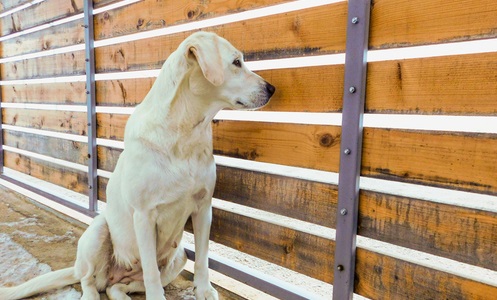Dogs and toddlers have a lot of similarities, but one of the most frustrating tendencies for parents – of both the human and pet variety – is a single-minded mission to get into places they shouldn’t be. No matter how often they’re reminded not to wander, it only takes a few moments for a mischievous canine to make their great escape.
A DIY dog gate can help save an exasperated human’s patience, whether it’s long-term or just until a more permanent solution can be implemented. Most can be set up quickly, often using materials that are found around the house, in the workshop, a junk drawer, or the craft room.
Learning His Escape Habits
There are various approaches to keeping a dog in one room (and out of another), but the best place to start is examining his escape routines. This can be done by “faking” inattention or leaving the room entirely; he’ll start to test his boundaries when he feels confident his pet parent isn’t watching closely. Another (and arguably more entertaining) option is setting up a spy camera pointed at his route to freedom and watching closely. This can be easily achieved with an inexpensive “nanny cam” or a webcam plugged into a laptop or computer in the room.
The type of technique he uses to get beyond barriers will be crucial when it comes to creating an effective DIY dog gate indoors. Below, some guidelines to determine exactly what type of escape artist your dog is:
- If he’s a pusher, he leads with his nose, muzzle, and head. He’ll wedge his nose under items in his way and do a canine impression of a bulldozer. He may patiently set his head against something in his way and push with his whole body until it’s out of the way.
A pusher needs: A strong, stable barrier, preferably one braced against something unmoving, such as a doorframe.
- If he’s a puller/pawer, he’s more interested in decimating his barriers, rather than overcoming them. He may insistently paw at the carpet under a door in an attempt to “dig” his way out. He may grip soft barriers or mesh in his teeth and tug at them until they rip or tear.
A puller/pawer needs: A solid barrier without any gaps or “give” that he can get his paws or teeth into in order to pull or tear.
- If he’s a quick escaper, he’s waiting for a convenient opportunity to zoom out of his confinement. He can be up and through a pair of legs in seconds, and often runs to the door so quickly his parents worry about him bonking his head.
A quick escaper needs: A difficult escape route that he can’t navigate quickly, and/or distractions to give his pet parent time to slip out while keeping him in the room.
- If he’s a jumper, he’s capable of getting some impressive vertical height, with or without a running start. The height of an average baby gate is something he could clear in his sleep, and he doesn’t hesitate to use his jumping superpower to travel where he pleases.
A jumper needs: A gate or barrier that he can’t just hop over – one that will get in the way of his sight lines and convince his doggy senses that it isn’t safe to prep for that flying leap he’s so eager to show off.
Exit Denied: Assessing The Gate Location

In the overwhelming majority of cases, a door frame will be where the DIY dog gate will need to be set up. Different attachment styles can be considered, depending on the pet parent’s needs – tension-oriented hardware for rental homes where nails and screws would be frowned upon, for instance. Another factor that should be heavily considered is convenience: while a dog barrier needs to keep a pup in, it can also be a pain for a human to dismantle or move each time they need to enter or exit a room.
Other members of the dog’s family should be considered as well – young children in particular. What may work just fine for a terrier can quickly fall apart in the determined hands of a toddler. Always assume that dogs and children will work together to remove barriers, and secure them accordingly.
Building A DIY Dog Gate Indoors
Once an installation spot has been located and assessed, it’s time to flex those creative muscles and start building. If a pet parent is familiar with woodworking, there are a number of plans available online for simple plank or barn gate-style projects, hung with hinges on the inside or outside of a door frame. If the dog in question is a puller/pawer, a wooden DIY indoor dog gate may need to be altered with a sheet of plywood instead of or over slat-style structures that he may chew on. If he’s a jumper, a few vertical pieces of wood may need to be added to discourage any attempts to hurdle a newly-built gate.
A few helpful DIY dog gate materials to consider for home usage include:
- Tension Rods: If table saws and levels aren’t a go-to, there are a number of alternate materials that can be used as well. For all dogs that aren’t pushers or puller/pawers, tension rods are an excellent alternative. Typically used in shower door frames or smaller closets, these rods are available at virtually any home goods store and set up in seconds. These can be set up as closely-spaced or as high up in the door frame as needed, working like horizontal bars to keep a curious pooch penned up and isolated to one room. The downside of this method is that each time a pet parent needs to exit the room, the tension rods will either need to be stepped over or taken down, if they’re set up high enough to stop a jumper.
- PVC Piping: A handsaw or hacksaw is all it takes to trim down PVC piping to the sizes needed for creating a simple frame. Using a combination of elbow joints and T joints, virtually any shape or silhouette can be created inexpensively – a real benefit if a door frame is large or wide. A barrier can either be created with fabric glued, stapled, or sewn around the frame, or with slender PVC pipes attached like bars within the frame itself using T joints. Depending on a dog’s behaviors, the frame can either be secured to the wall (pipe straps work well), or left free-standing as a visual deterrent.
- Fabric: Those handy with a sewing machine can whip up a dog barrier quickly and easily. Simply measure the door frame dimensions that need to be blocked off, and sew two pieces of cloth of the appropriate size together to make a durable double-thick panel. Add a grommet in each of the four corners, and addition grommets down the sides if necessary. Use non-residue command-style hooks on the outside of the door frame and either hang the grommets on these hooks directly, or use short bungee cords to keep the fabric taut.
- Mesh or Screens: If a visual deterrent is enough to keep a dog in place, mesh and screens make a great alternative to more complex DIY dog gate options. Metal meshes can be attached with something as simple as magnetic stripping, while accordion-style room screen dividers simply rest in the doorway. If there’s a gap under a folding screen that may entice puller/pawers, attach fabric with Velcro tape along this edge as an additional deterrent.
Reinforce Gates With Behavior

Like toddlers, dogs will cheerfully and constantly test boundaries – both the physical variety and their parents’ patience. While a DIY dog gate is a great first step in enforcing where he can and cannot go, some extra reminders don’t hurt either. Attach loud bells or even empty cans (carefully trimmed of sharp edges) to a DIY gate to ensure he can’t sneak over or around without garnering attention. Use the aforementioned spy camera and watch him to see how he tries to navigate the barrier – then correct and improve those behaviors as needed.
Finally, bear in mind that a DIY indoor dog gate is seldom a permanent solution. The odds are that at least some of its components will need repair in time, or total replacement with a more purpose-built solution, such as a baby gate. Any barrier that keeps a dog where he’s supposed to be is a successful one; however, so don’t be afraid to experiment with combining different methods to see what works best.
Sources Cited:
- Barnes, Liam. “25 DIY Indoor Dog Gate and Pet Barrier Ideas.” PlayBarkRun.com, October 19, 2019, https://www.playbarkrun.com/diy-indoor-dog-gate-and-pet-barrier-ideas/. Accessed September 21, 2020.
- “10 Minute DIY Baby/Pet Gate (Update 2018).” Finding Purpose Blog (findingpurposeblog.com), August 2, 2018, https://www.findingpurposeblog.com/10-minute-diy-babypet-gate/. Accessed September 21, 2020.
- Rascoe, Kelli. “How to Make a DIY Dog Gate at Home.” Trupanion (trupanion.com), September 8, 2020, https://trupanion.com/blog/2020/09/diy-dog-gate/. Accessed September 21, 2020.
- “DIY Pet Barrier – 3 Homemade Dog Gates.” PatchPuppy.com, (no published date), https://patchpuppy.com/diy-puppy-love/diy-pet-barrier/. Accessed September 21, 2020.




